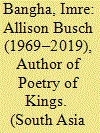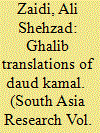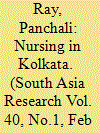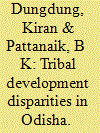|
|
|
Sort Order |
|
|
|
Items / Page
|
|
|
|
|
|
|
| Srl | Item |
| 1 |
ID:
170669


|
|
|
| 2 |
ID:
170668


|
|
|
|
|
| Summary/Abstract |
This issue of South Asia Research (SAR) marks and celebrates 40 years of an academic venture that began in very different conditions than one faces in publishing today. Initially, it was quite a modest in-house product, with the first issue of this journal published in May 1981. The decision at SOAS in 1980 to establish a journal run by doctoral students involved a team including the historian Rosalind O’Hanlon, now Professor of Indian History and Culture at Oxford, the historian Vanessa Harvey-Samuel and the anthropologist Catherine Thompson. The moment of taking the initiative to use print to stimulate progress, academically as well as personally, matches remarkably well with the research focus of many South Asianists on the role of the printing press. It appears in the work of O’Hanlon herself on Marathi sources and is still present in recent studies that illustrate, for example, how a Tamil religious leader and his followers ‘used print as a tool to garner religious and textual authority’ (Weiss, 2019: 52). Seen in this light, the creation and production of SAR was a landmark event in the development of South Asian Studies not just at SOAS but globally. Forty years later we are, indeed, a truly global journal, respected (and cited) worldwide.
|
|
|
|
|
|
|
|
|
|
|
|
|
|
|
|
| 3 |
ID:
170676


|
|
|
|
|
| Summary/Abstract |
Daud Kamal (1935–87), the preeminent English language poet of Pakistan, left behind many unpublished translations of poems by the classical Urdu poet Mirza Ghalib (1797–1869). This article presents and discusses several of these translations in the light of historical events during Ghalib’s lifetime. Although he endured many personal tragedies, Ghalib attained mystical heights that confirm his stature as the greatest Urdu poet.
|
|
|
|
|
|
|
|
|
|
|
|
|
|
|
|
| 4 |
ID:
170671


|
|
|
|
|
| Summary/Abstract |
Research on ‘care work’ tends to focus on relations between gender and ‘care’ at the cost of obfuscating caste and class markings that devalue such labour. This article argues that the service work of the contemporary nursing profession, as observed in Kolkata, continues to be devalued, not because it is care work but because it is linked to low-caste/out-caste women who have historically provided nursing care. To counter such stigma, nursing has witnessed a splintering along the lines of ‘prestigious’ and ‘dirty’ work. This cleavage, based on historically and socially produced structural inequalities, is supported both by organisational strategies and a privileged section of workers, who deploy ‘merit’ or cultural capital to close ranks against others. The article examines how women located at the bottom of this hierarchy resist such strategies. What does ritual, banal everyday resistance imply for processes and practices that reproduce organisational inequalities?
|
|
|
|
|
|
|
|
|
|
|
|
|
|
|
|
| 5 |
ID:
170672


|
|
|
|
|
| Summary/Abstract |
Greater engagement of businesses in development in South Asia reflects a partial withdrawal of the state from providing all kinds of services. Advocates of ‘bottom of the pyramid’ approaches have argued that corporations can step in by simultaneously making profit and contributing to development goals, including rural poverty reduction. The article investigates such claims, by using two initiatives of Information and Communication Technology business designed to serve and uplift poor people by GrameenPhone Limited, a major mobile phone operator in Bangladesh, to gauge the probability of positive development outcomes for the rural poor.
|
|
|
|
|
|
|
|
|
|
|
|
|
|
|
|
| 6 |
ID:
170673


|
|
|
|
|
| Summary/Abstract |
This article examines and compares the status of land rights and their impacts on agricultural productivity, food security and well-being in a set of tribal and non-tribal villages in Telangana. Based on an intensive field survey, the research confirms that tribals without formal land rights remain largely unable to benefit from government support and access to private institutions in terms of getting credit and farm extension, whereas in non-tribal villages, government organisations are pro-active in providing such support. These findings confirm the need to increase the effectiveness of land rights and title documentation in India’s tribal villages to protect local people’s investments in land, enhance agricultural productivity and strengthen the long-term effectiveness of government programmes, which include avoidance of migration to the big cities
|
|
|
|
|
|
|
|
|
|
|
|
|
|
|
|
| 7 |
ID:
170674


|
|
|
|
|
| Summary/Abstract |
The well-known phenomenon of tribal disadvantage in India requires constant monitoring to ensure diligent attention to equitable protection of tribal people’s right to life. This article, based on an analysis of primary data collected from 400 households in eight different tribal communities in Odisha, charts the differential progress of Odisha tribals by establishing a Tribal Development Index. Such data identify significant development disparities and confirm the existence of a ‘creamy layer’, constituted of more developed individuals and families also among India’s tribals. While many households in these eight communities still lack basic amenities, notable differences regarding food security, landholding, income and overall development were identified, supporting arguments for devising more sophisticated differential forms of intervention.
|
|
|
|
|
|
|
|
|
|
|
|
|
|
|
|
| 8 |
ID:
170670


|
|
|
|
|
| Summary/Abstract |
In the post-1857 context of an earlier plural Dravidian social and political landscape, this article highlights the efforts of Vanniyars during the period 1900–35 in Tamil Nadu to articulate their claims for social and political mobility. Such efforts entailed the process of creating and forming a Vanniyar self-identification within the context of complex forces operating at the larger and emerging national and regional levels at that time. Presenting these Vanniyar enunciations, the article argues against a tendency in scholarship to see pluralisation as a recent phenomenon associated with the post-1980s Tamil politics. It also places the developments in South India within the larger picture of Indians learning to become responsible citizens.
|
|
|
|
|
|
|
|
|
|
|
|
|
|
|
|
| 9 |
ID:
170675


|
|
|
|
|
| Summary/Abstract |
This article examines the intersections of fitness, consumption, the middle class and the female body in contemporary India. Having grown up exposed to and interacting with global markets, brands and commodities, young middle-class Indian women seek to engage in cultural practices that distinguish them as members of an upwardly mobile class of urban professionals. For many young women, working out at a gym or fitness centre has become an important performative act that signifies ability to successfully navigate the globalised and cosmopolitan worlds. Drawing mainly from ethnographic fieldwork, the article suggests that the fit, young, middle-class body has become the ‘right’ female body in contemporary India and functions to reinforce a privileged social location. It underpins moralities of self-care and marks the rise of the global Indian woman prepared to tackle multiple roles and responsibilities.
|
|
|
|
|
|
|
|
|
|
|
|
|
|
|
|
|
|
|
|
|